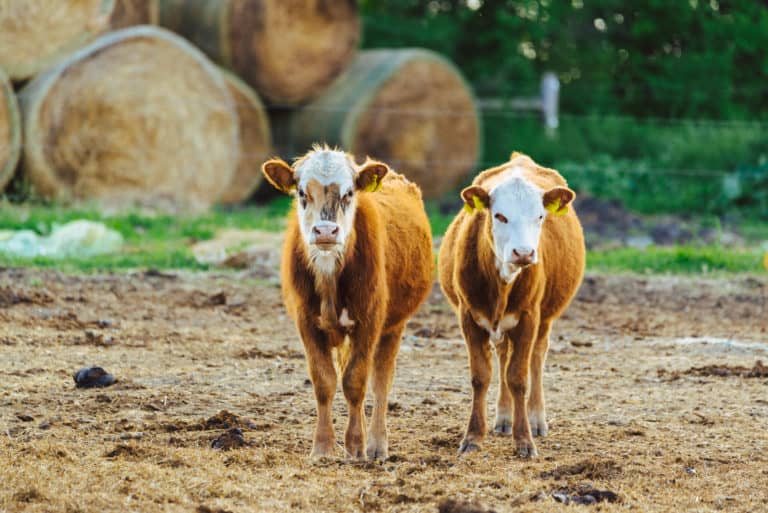Holy cow has the weather changed the past few weeks. Cooler nights and very pleasant daytime temperatures. This month I would like to touch on DEHORNING calves. When is the appropriate time and method to use? I have probably done and have experience with all methods of dehorning calves.
Obviously the “Yeh Hay “moment is when you have a polled animal. Who doesn’t love those? In deciding on a dehorning method, it is beneficial to understand the anatomy of the horn itself. The site of horn production is cells within the corium located at the junction of the horn and skin. At birth, a calf’s horns begin as a bud that is essentially free floating within the skin on the calf’s head. If the bud is removed but the corium is not, horn growth will continue to take place. It takes about 6 to 8 weeks for the horns to begin to attach to the frontal bone of the skull.
Attachment to the skull also gives the horn access to the frontal sinus, which lies within the skull beneath the horn bud. Around this time, the cornual nerve also provides sensation to the skin of this region, thus the need for additional pain management techniques when dehorning is done at later stages of a calf’s life. After 6 months of age, the horn bone will become hollow, but is now open to the frontal sinus of the skull and filled with blood vessels and tissue, creating more problems if dehorning is prolonged to this point.
Since the anatomy of the horn changes as the calf grows, there are different dehorning options for the various stages of growth. Because of the horn growth process, dehorning at the earliest age is preferred to minimize pain as well as injury to the sinuses of the calf. Not only does early dehorning have these benefits, but early dehorning can be less stressful to the calf and requires a lot less physical restraint from the handler. When horn buds are removed early in life it is referred to as disbudding, since the techniques are removing the horn-producing cells as opposed to an already formed horn.
The earliest dehorning option for calves is chemical dehorning with a caustic paste. For the best effectiveness of this product, it is recommended that a dime sized amount of paste be applied to shaved horn buds of calves less than 24 hours old. In the initial stages of life, the calf is unable to pinpoint the source of irritation, and therefore does not use its foot to try to rid itself of the paste. However, this reaction quickly develops and after a few days, calves can create additional injuries to themselves and handlers as they try to scratch the paste off.
This can spread the paste and create secondary burns to other areas of the body such as the eyes and possibly blind the calf. Another threat to the caustic paste is rainy weather. Do not apply paste to calves housed outdoors when the 24-hour forecast calls for rain. The rain could potentially wash the paste away and then the process would have to be repeated. Calves housed indoors would obviously not face this challenge. Caustic pastes can be applied up to 2 weeks of age; however, restraint of the calf, its ability to scratch the paste off, and other potential complications increase with increased age.
Some paste users recommend covering freshly applied paste with either duct tape or vet wrap to protect the paste and keep it in place, removing it once the paste has had sufficient time to work. Producers using this method should always use gloves when handling the paste. Proper pain relievers should also be given to calves to minimize the effects of the caustic paste.
Hot iron dehorning is the most popular method of disbudding/dehorning calves. This method can be used as early as the horn bud can be felt on the calf and is most effective when done up to 3 months of age. This procedure requires more pain control for the calf as well as more handler restraint. When using hot iron dehorning, nerve blocks are recommended prior to dehorning as well as additional pain relievers. There are many different types of burners on the market for this procedure as well as different tip options for various sized horns. Regardless of the type, the tip of the burner should be just wider than the horn to achieve proper cauterization around the base of the horn. Calves need to be properly restrained to avoid injury to the calf as well as those performing the procedure. Hot iron dehorners should be applied to shaved horn areas, held onto the horn with slight pressure and rotated back and forth by twisting your wrist to achieve a proper burn, leaving a nice copper-colored ring around the base of the horn. Burners left on too long can create deep burns that can cause more damage to the calf and lead to an increased chance of infection. Liquid bandages can be applied to the burn site as well as fly control to prevent the instance of maggots.
Proper pain management for the calf is essential regardless of the dehorning method. All producers need to work with their veterinarians to ensure that standard operating procedures (SOP) are in place to make their calves as comfortable as possible during dehorning. There are dehorning options available for more advanced horns but they tend to be much more painful to the animals as well as result in more blood loss and the chance for additional complications. The key to dehorning is the earlier it can be done, the better!
Of course, we cannot forget to consider the option of polled genetics for calves born free of horns. Farmers tend to choose sire mates for their cows to improve qualities such as milk production, calving ease, better feet and legs, etc. However, there are options available where producers can choose to select sires that carry the polled gene to incorporate polled calves into their herds. According to the Northeast Organic Dairy Producers Alliance, the polled gene is dominant and needs to be present in only one parent. Breeding a typical dairy herd to polled bulls results in a minimum of 50% hornless calves and in just one generation an entire herd can become half polled. Using a homozygous polled sire has even greater impact because all of his calves will be polled. The Alliance also boasts that utilizing the polled gene is easier than ever before with additional sires available through artificial insemination. Eliminating the stress, pain, time, and equipment necessary to dehorn calves through polled genetics should be a major consideration when thinking of the future of your herd.
So with that being said, Lets have a goal for sooner is better with minimal regrowth on all our animals.
Any questions regarding dehorning, feel free to reach out to me:
Minnie Ward
507-259-6534

